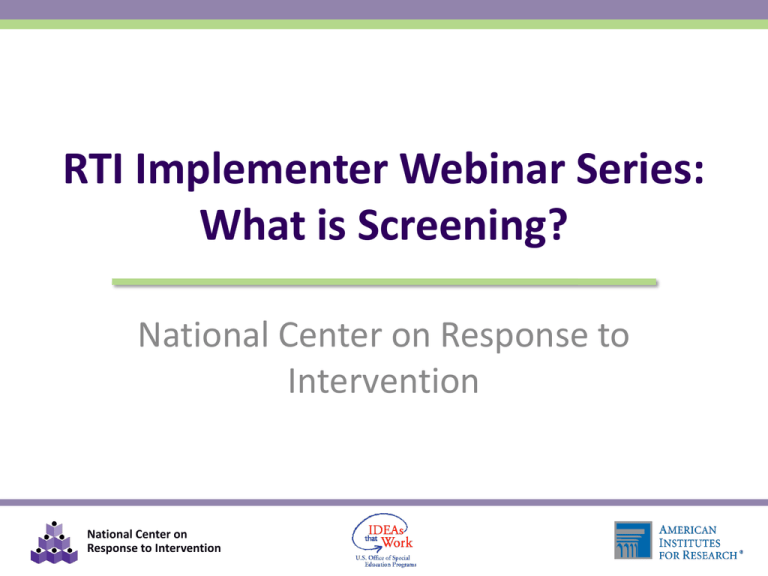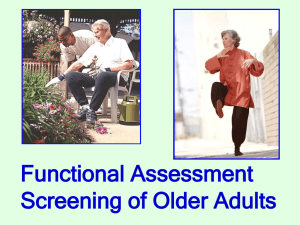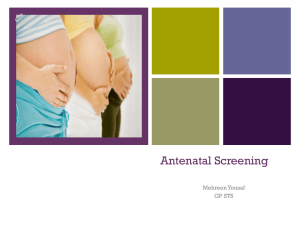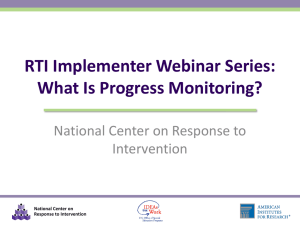PowerPoint Slides - National Center on Response to Intervention
advertisement

RTI Implementer Webinar Series: What is Screening? National Center on Response to Intervention National Center on Response to Intervention RTI Implementer Series Overview Introduction Screening Progress Monitoring Multi-level Prevention System Defining the Essential Components What Is RTI? What Is Screening? What Is Progress Monitoring? What Is a Multilevel Prevention System? Assessment and Data-based Decision Making Understanding Types of Assessment within an RTI Framework Using Screening Data for Decision Making Using Progress Monitoring Data for Decision Making IDEA and Multilevel Prevention System Establishing Processes Implementing RTI Establishing a Screening Process National Center on Response to Intervention Selecting Evidence-based Practices 2 Upon Completion Participants Will Be Able To: Recognize the purpose and focus of screening Use the Screening Tools Chart to learn about screening tools Understand the timeframe for screening National Center on Response to Intervention 3 Vocabulary Handout Word Prediction Final Meaning Primary prevention level The bottom of the pyramid that represents instruction given to students without learning problems Instruction delivered to all students using research-based curricula and differentiation in the general education classroom. Incorporates universal screening, continuous progress monitoring, and outcome measures or summative assessments. National Center on Response to Intervention Picture/Sketch/Example Primary prevention 4 Essential Components of RTI National Center on Response to Intervention 5 Screening PURPOSE: identify students who are at risk of poor learning outcomes FOCUS: conducted for all students TOOLS: involves brief assessments that are valid, reliable, and evidence based TIMEFRAME: administered more than one time per year (e.g., fall, winter, spring ) National Center on Response to Intervention 6 Examples of Common Screening Processes National Center on Response to Intervention 7 Purpose of Screening Identify students at risk for poor learning outcomes Identity students who need additional assessment (i.e., progress monitoring) and instruction (i.e., secondary or tertiary) Provide data on the effectiveness of the core instruction and curriculum National Center on Response to Intervention 8 Focus of Screening Screening typically includes all students Two-stage screening process • • Stage 1: Universal screening Stage 2: More in-depth testing or progress monitoring for students who scored at or below the cut score to verify whether they are or are not truly at risk Should be an educationally valid outcome National Center on Response to Intervention 9 Screening Tools Must choose reliable, valid tools that demonstrate diagnostic accuracy Must choose age-appropriate outcome measures that capture student ability May have different screeners to assess different outcome measures National Center on Response to Intervention 10 CBM Passage Reading Fluency Student copy National Center on Response to Intervention 11 NCRTI Screening Tools Chart http://www.rti4success.org/screeningTools National Center on Response to Intervention 12 Tips for Using the Tools Chart 1. Gather a team 2. Determine your needs 3. Determine your priorities 4. Familiarize yourself with the content and language of the chart 5. Review the data 6. Ask for more information National Center on Response to Intervention 13 1. Gather a Team Who should be involved in selecting a screening tool? What types of expertise and what perspectives should be involved in selecting a tool? National Center on Response to Intervention 14 2. Determine Your Needs For what skills do I need a screening tool? For which specific academic outcome or measure am I interested in screening? For what grades do I need a screening tool? Will this screening tool be used with all students or only a specific subgroup(s) of students? Which subgroup(s)? National Center on Response to Intervention 15 3. Determine Your Priorities Is it a tool that can be purchased for a reasonable cost? Is it a tool that does not take long to administer and score? Is it a tool that offers ready access to training and technical support for staff? Is it a tool that meets the highest standards for technical rigor? Is it a tool whose effectiveness has been studied and demonstrated in my district or state? National Center on Response to Intervention 16 4. Familiarize Yourself With the Content and Language of the Chart 1. Ratings of technical rigor: 2. The efficiency of the tool 3. Implementation requirements for the tool 4. Detailed data submitted by the vendor National Center on Response to Intervention 17 Content and Language of Chart Technical rigor: • • • • • Classification Accuracy Generalizability Reliability Validity Disaggregated data National Center on Response to Intervention 18 Content and Language of Chart Efficiency: • • • • Administration format Administration and scoring time Scoring key Norms/benchmarks National Center on Response to Intervention 19 Content and Language of Chart Implementation Requirements: • Cost of tool • Training required to implement tool • Level of expertise required to administer tool • Training and technical support offered • How scores are reported National Center on Response to Intervention Click name of tool to view “implementat ion table” 20 Content and Language of Chart Data: • Detail about data submitted to TRC. • Look for tools that conducted classification studies with outcome measures and samples similar to your population and outcome of interest. • More information to help you determine which tool(s) is most appropriate for which populations of students. National Center on Response to Intervention Click on any rating bubble to view data 21 5. Review the Data National Center on Response to Intervention 22 6. Ask for More Information National Center on Response to Intervention 23 The NCRTI Screening Tool Chart User Guide National Center on Response to Intervention Timeframe Screening typically occurs at least three times a year. • Fall, winter, spring • Should remain consistent across school years and sites Screeners must target skills pertinent to the grade and time the screen is administered. Delivery option: • Individually administered test: approximately 1–5 minutes • Class-wide tests: range from 2–60 minutes National Center on Response to Intervention 25 Need More Information? National Center on Response to Intervention www.rti4success.org RTI Action Network www.rtinetwork.org IDEA Partnership www.ideapartnership.org National Center on Response to Intervention 26 National Center on Response to Intervention This document was produced under U.S. Department of Education, Office of Special Education Programs Grant No. H326E07000.4 Grace Zamora Durán and Tina Diamond served as the OSEP project officers. The views expressed herein do not necessarily represent the positions or policies of the Department of Education. No official endorsement by the U.S. Department of Education of any product, commodity, service or enterprise mentioned in this publication is intended or should be inferred. This product is public domain. Authorization to reproduce it in whole or in part is granted. While permission to reprint this publication is not necessary, the citation should be: www.rti4success.org. National Center on Response to Intervention 27









